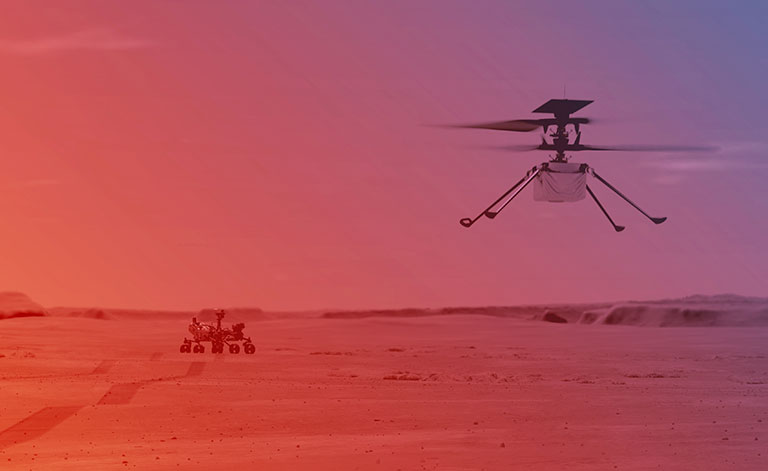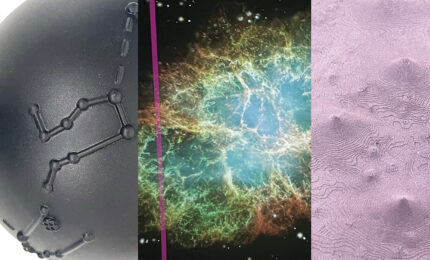On February 18, scientists and space fans alike had their eyes glued to their screens, nervously and excitedly watching a momentous landing. NASA’s Perseverance rover, a science lab the size of a small car, hurtled toward the surface of Mars at 12,500 miles per hour. Even after firing thrusters and parachuting, the rover needed to further slam the brakes, accomplished by a “sky crane” that gently lowered it with a tether. After seven eventful minutes, at 3:55 p.m. Eastern time, a sufficiently slowed-down rover finally set its wheels down on the ruddy Martian soil.

An illustration shows Perseverance making its way toward Mars. Illustration: NASA/JPL-Caltech
Carnegie Science Center hosted a socially distanced landing party with some 40 visitors, including kids dressed up in flight suits, and hundreds more spectators following along virtually. “I remember the moment that we landed because everyone started jumping up and down and cheering,” says Mike Hennessy, Science Center educator and manager of its Buhl Planetarium.
After the successful landing, Perseverance —or Percy, as it’s sometimes called—sat for a couple of weeks in the middle of Jezero Crater, readying for its missions. It’s thought to be the site of an arid, ancient delta, where liquid water once flowed more than 3 billion years ago. NASA scientists suspect that if fossilized microbes exist on Mars, they could be trapped in clay mineral deposits along the crater’s dried-up lake bottom, shorelines, and river delta.
Before venturing into the alien terrain, the rover performed a series of self-checks to ensure that its seven primary instruments, including a pair of its 23 cameras, were working properly. Its sidekick, a 4-pound helicopter known as Ingenuity, made its historic first flight in late April, scoping out the wider area and performing reconnaissance before Percy sallies forth.

Perseverance took this image of the tracks it made following its first drive on the Martian surface. Photo: NASA/JPL-Caltech
Over the next two years, a dedicated team of scientists and engineers will make the most of Perseverance’s presence on the red planet. They’ll pilot the scrappy rover remotely to explore new environments, probe the geological history, search for signs of alien life, and prepare for future robotic and crewed missions to this mysterious world.
Following the water
Perseverance has a full itinerary. Once the rover’s ready to explore the Martian environment it landed in, it will trundle around the delta, using its instruments to look for signs of liquid water in the past. While water would evaporate instantly on today’s Mars, some scientists think that eons ago the planet used to be more like Earth. Mars once sported lakes and flowing rivers, including one that washed into Jezero. Although some ice remains on the now-desiccated world, the water and the atmosphere disappeared long ago, likely making it uninhabitable now.
The layers of Martian rocks beneath Perseverance’s wheels bear tales of the planet’s distant past. “It’s really exciting trying to put together the larger story,” says Pamela Conrad, an astrobiologist at the NASA Goddard Space Flight Center. “It’s like a jigsaw puzzle, with everybody doing the edges first. And then you figure out where you’re going to go next.”
“It’s really exciting trying to put together the larger story. It’s like a jigsaw puzzle, with everybody doing the edges first.” – Pamela Conrad, NASA Astrobiologist
The most advanced rover ever sent to another world is equipped with precious cargo, tools to detect signs of ancient life hidden within the rocks. Initial Martian images suggest that Perseverance’s job will be complicated by the fact that an ancient lava flow seemed to have oozed through the area long ago, but tiny organisms would be more likely to survive in the mud at the bottom of a lake than in such volcanic rocks. Wherever the rover heads, however, scientists will take advantage of its images and other data, seeking evidence of chemicals that lifeforms might produce and that aren’t usually found in lifeless places.
“Some scientist in the 2030s is going to be handed a sample and told, ‘Go look for life in this rock, but not life as we know it,’” says Kenneth Farley, a planetary scientist at the California Institute of Technology. “There’s still debate about what it even means to be alive. I think that will be fascinating because it’s the kind of problem that will force science to grow.”
To enable that kind of research to develop, Perseverance can’t be the only one sifting through the Martian dirt and poking around the rocks. NASA wants to bring some of those space rocks back to Earth for study with a “sample return” mission. That means Percy needs to be selective and pick the best sample, which can’t weigh much more than a single pound so that it could be loaded on a small rocket and launched back in a few years.
Hunting for extremophiles
The scientists guiding Perseverance have their work cut out for them, since part of their job involves preparing for upcoming missions. That includes anticipating the needs and challenges of the next generation of astronauts, who could eventually set foot on Earth’s closest planetary neighbor within the next 20 or 30 years. For example, the rover is equipped with an instrument called MOXIE that extracts oxygen from carbon dioxide in the Martian atmosphere. Future Martian visitors will need that air to breathe, after all, and oxygen can be used to make rocket propellant to fuel the astronauts’ return home.
Researchers also use the rover’s cameras and meteorological sensors to keep track of the Martian weather and climate. “Mars is a pretty dusty place,” says Mariah Baker, a planetary scientist at the Smithsonian Institution’s National Air and Space Museum. “Especially once we start thinking about putting humans on the surface, the need to keep those explorers safe is increased. Understanding the wind and dust environment is going to be crucial for future exploration.” Getting caught in a dust storm might not be as risky as the one that stranded Mark Watney in the fictional tale The Martian, but if the planet’s wind hurls dust and sand into astronauts’ suits or damages critical equipment, it could put their mission in jeopardy.

A NASA engineer readies for the mission by using a solar intensity probe to measure and compare the amount of artificial sunlight that reaches different portions of the rover. To avoid contaminating the Mars surface with Earth organisms such as bacteria or spores, the work was performed in a clean room inside the Jet Propulsion Laboratory. Photo: NASA/JPL-Caltech
Missions on the moon play a role in preparing for the red planet, too. That includes NASA’s Moon to Mars campaign, which involves landers, rovers, and, as early as 2024, astronauts on the lunar surface. By then, Astrobotic Technology Inc., a Pittsburgh-based private space company, will deliver a small, water-hunting rover named VIPER to the moon for NASA— perhaps a precursor for something that would later be launched to Mars. “Over time, we’ll need to figure out how to extract frozen water that’s meters down below the surface,” explains John Thornton, Astrobotic’s CEO. “It’s a very challenging environment. You have to be able to capture it, isolate it, and purify it.”
Building on this excitement, the Moonshot Museum will open in summer 2022 on Pittsburgh’s North Side. Located at Astrobotic’s headquarters, the Moonshot Museum’s exhibitions focused on a return to the moon will tie directly to a new Science Center exhibition, set to open in fall 2022, creating an immersive opportunity for Pittsburghers related to space exploration.
“Some scientist in the 2030s is going to be handed a sample and told, ‘go look for life in this rock, but not life as we know it.’” – Kenneth Farley, planetary scientist, California Institute of Technology
Most space environments, including on Mars, have only trace amounts of water, limited sources of energy, and extreme temperatures. Scientists dub the tiny organisms that survive in these environments “extremophiles” and they live on Earth, too, including the nearly indestructible creatures known as tardigrades, which can live years without food or water. “Finding evidence of microbes on Mars would expand the view that life is hardy,” says the Science Center’s Hennessy.
Venus, Earth, and Mars span the traditional “habitable zone” of our solar system, the region around the sun where one might find liquid water and have enough solar energy without it being too cold or too hot. But the possibilities of life extend beyond that limited range.

An illustration of Ingenuity the helicopter flying on Mars, with the rover in the background. Illustration: NASA/JPL-Caltech
Other, frigid worlds farther from the sun might still have microbes thriving below ground, where it’s warmer and chemical sources of energy could arise. The top candidates include “ocean worlds” with underground water hidden below an icy crust, like Europa, one of Jupiter’s moons, and Enceladus and Titan, two of Saturn’s moons. The helicopter Ingenuity, which is having its Wright brothers moment as the first aircraft to make a powered, controlled flight on another planet, sets the stage for Dragonfly. The latter’s a proposed mission to send a chopper to Titan in the 2030s, and it will benefit from Ingenuity’s experience. Other distant voyages will surely follow.
Space missions take years or even decades of work by hundreds of scientists and engineers, carefully designing every piece of equipment (and its backups) and preparing for every possible scenario. Many Mars missions by NASA and other space agencies have failed, but Perseverance benefited from building on the success of the Curiosity rover. Perseverance launched on July 30, 2020, from Cape Canaveral Air Force Station in Florida, eight years after Curiosity, which amazingly is still active on the red planet nearly eight years later. After traveling an extraordinary 293 million miles over nearly seven months, Perseverance finally reached its destination and made its dramatic touch down.
“Through the power of the planetarium, we immerse guests in a parachute descending through the Martian atmosphere,” says Hennessy. “Students discover a secret binary code message from the NASA Mars rover team in the parachute’s orange and white stripes that reads, “Dare Mighty Things,” a quote from Teddy Roosevelt. Our fascination with Mars continues to inspire the next generation to dare mighty things and imagine their own bright futures on Earth.”

A mosaic of the Valles Marineris hemisphere of Mars projected into point perspective, a view similar to what one would see from a spacecraft. Photo: NASA/JPL-Caltech
Since the ancient Sumerians gazed at Mars millennia ago, the red planet has long captivated us. It’s a largely unknown world that seems both near and far from our own, and it’s a possible host of life, or a former one, that could tell us whether we’re not alone in the universe. We’ve come a long way since H.G. Wells and others thought they caught glimpses of networks of canals marking the surface, but we still have much to learn.
Visitors to the Science Center’s Buhl Planetarium can explore the latest and greatest science and engineering now underway in a special Mission to Mars show.
NASA and other space agencies will surely continue to send rovers, robots, and eventually scientists to Mars for decades to come. Though the planet’s named after the Roman god of war, it’s already becoming the next major site of peaceful and international exploration.







